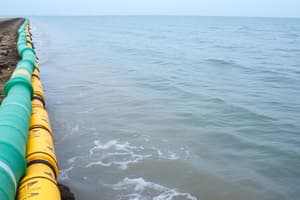Podcast
Questions and Answers
What are the three main methods for offshore oil spill response?
What are the three main methods for offshore oil spill response?
Skimming, in situ burning, and chemical dispersants
Which of the following is NOT a condition for successful skimming?
Which of the following is NOT a condition for successful skimming?
- Calm seas
- Thick oil slick
- Strong winds (correct)
- Daylight
In situ burning involves burning the oil directly on the ocean surface to reduce its volume.
In situ burning involves burning the oil directly on the ocean surface to reduce its volume.
True (A)
What is the main benefit of using chemical dispersants in an oil spill response?
What is the main benefit of using chemical dispersants in an oil spill response?
When is it NOT recommended to use chemical dispersants?
When is it NOT recommended to use chemical dispersants?
Match each oil spill cleanup method with its ideal condition for success:
Match each oil spill cleanup method with its ideal condition for success:
What is meant by an "encounter rate" in relation to skimmers?
What is meant by an "encounter rate" in relation to skimmers?
What is the purpose of a fire-retardant boom in in situ burning?
What is the purpose of a fire-retardant boom in in situ burning?
Natural dispersion of oil is a slower process than using chemical dispersants.
Natural dispersion of oil is a slower process than using chemical dispersants.
Why is air monitoring essential during in situ burning?
Why is air monitoring essential during in situ burning?
Flashcards
Oil Spill Skimming
Oil Spill Skimming
Removing oil from the water's surface using specialized equipment.
Oil Skimmers
Oil Skimmers
Equipment used to collect oil from the water surface; often in the form of disks or floating drums.
Skimming Success Conditions
Skimming Success Conditions
Calm seas, daylight, thick oil layer are ideal conditions for skimming effectiveness.
Skimmer Challenges
Skimmer Challenges
Signup and view all the flashcards
In Situ Burning
In Situ Burning
Signup and view all the flashcards
In Situ Burning Process
In Situ Burning Process
Signup and view all the flashcards
In Situ Burning Conditions
In Situ Burning Conditions
Signup and view all the flashcards
In Situ Burning Considerations
In Situ Burning Considerations
Signup and view all the flashcards
Chemical Dispersants
Chemical Dispersants
Signup and view all the flashcards
Dispersant Benefits
Dispersant Benefits
Signup and view all the flashcards
Dispersant Environmental Concerns
Dispersant Environmental Concerns
Signup and view all the flashcards
Dispersant Success Conditions
Dispersant Success Conditions
Signup and view all the flashcards
Natural Dispersion
Natural Dispersion
Signup and view all the flashcards
Oil Spill Response Methods
Oil Spill Response Methods
Signup and view all the flashcards
Study Notes
Oil Spill Cleanup Methods
- Oil spill cleanup uses various methods, like tools for home repairs.
- Key offshore methods include skimming, in-situ burning, and chemical dispersants.
Skimming
- Removes oil from the water surface, preventing coastal impact.
- Equipment: Various types (e.g., disks, drums) collect oil.
- Collected oil is transferred to collection tanks.
- Optimal conditions: Calm seas, daylight, thick oil slick.
- Challenges: "Encounter rate" (direct contact needed); often collects oil-water mixture.
In-Situ Burning
- Burns oil directly on the water surface to reduce volume.
- Method: Fire-retardant boom concentrates oil for burning.
- Optimal conditions: Mild winds, calm seas, daylight, thick oil layer.
- Environmental considerations: Crucial air monitoring (smoke and residue effects).
Chemical Dispersants
- Sprays onto oil slick to break down oil into smaller droplets.
- Benefits: Smaller droplets allow quicker microbial breakdown.
- Environmental considerations: Potential harm to marine life (water column and seafloor); careful use.
- Optimal conditions: Daylight, mild winds, moderate seas, away from shore/shallow water.
- Natural dispersion: Waves can naturally break oil; dispersants speed up this process.
Ideal Conditions Summary
- Skimming: Calm seas, daylight, thick oil.
- In-Situ Burning: Mild winds, calm seas, daylight, sufficient oil thickness.
- Chemical Dispersants: Daylight, mild winds, moderate seas, away from sensitive areas.
Studying That Suits You
Use AI to generate personalized quizzes and flashcards to suit your learning preferences.




